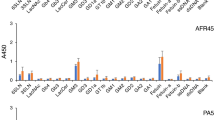Summary
We have developed an immunohistochemical method for the in vivo and in vitro detection of glycosyl receptors in rat spleen and lymph nodes by using neoglycoproteins. The receptor in both organs recognized mannose coupled to bovine serum albumin (mannose-BSA), fuscose-BSA, N-acetylglucosamine-BSA and to a lesser extent glucose-BSA, but not galactose-BSA or N-acetylgalactosamine-BSA. In vitro neoglycoprotein-receptor binding was Ca2+ dependent and could be inhibited by mannan but not by mannose. Simultaneous staining with the monoclonal antibodies ED1, ED2 or ED3 revealed that only ED1-and ED3-positive macrophages were involved in the binding of neoglycoproteins. In the spleen, the marginal-zone macrophages and a subpopulation of the marginal metallophils possess glycosylbinding receptors. In the lymph nodes, the medullary sinus macrophages and a subpopulation of the outercortex macrophages are able to bind neoglycoproteins.
Similar content being viewed by others
References
Amlot PL, Grennan D, Humphrey JH (1985) Splenic dependence of the antibody response to thymus-independent (TI-2) antigens. Eur J Immunol 15: 508–512
Ashwell G, Harford J (1982) Carbohydrate-specific receptors of the liver. Ann Rev Biochem 51: 531–554
Bardosi A, Dimitri T, Gabius H-J (1988) (Neo)glycoproteins as tools in neuropathology: histochemical patterns of the extent of expression of endogenous carbohydrate-binding receptors, like lectins, in meningiomas. Virchows Arch [B] 56: 35–43
Bardosi A, Dimitri T, Gabius H-J (1989a) Are glycoconjugates and their endogenous receptors involved in the fusion of mononuclear macrophages resulting in multinucleate giant cells? J Submicrosc Cytol Pathol 21: 229–238
Bardosi A, Dimitri T, Wosgien B, Gabius H-J (1989b) Expression of endogenous receptors for neoglycoproteins, especially lectins, that allow fiber typing on formaldehyde-fixed, paraffinembedded muscle biopsy specimens. A glycohistochemical, immunohistochemical, and glycobiochemical study. J Histochem Cytochem 37: 989–998
Chao D, MacPherson GG (1989) Lymph node macrophage heterogeneity: the phenotypic and functional characterization of two distinct populations of macrophages from rat lymph node. Eur J Immunol 19: 1273–1281
Claassen E, Kors N, Van Rooijen N (1987) Immunomodulation with liposomes: the immune response elicited by liposomes with entrapped dichloromethylene-diphosphonate and surface associated antigen or hapten. Immunology 60: 509–515
Claassen E, Westerhof Y, Versluis B, Kors N, Schellekens M, Van Rooijen N (1988) Effects of chronic injection of sphingomyelincontaining liposomes in lymphoid and non-lymphoid cells in the spleen. Transient suppression of marginal zone macrophages. Br J Exp Pathol 69: 865–875
Dijkstra CD, Döpp EA, Joling P, Kraal G (1985) The heterogeneity of mononuclear phagocytes in lymphoid organs: distinct macrophage subpopulations in the rat recognized by monoclonal antibodies ED1, ED2 and ED3. Immunology 54: 589–599
Dimitri T, Bardosi A, Gabius H-J (1989) Mapping of receptors for carbohydrate constituents of glycoconjugates in well-differentiated and malignant ependymomas: a glycohistochemical study. Neuropathol Appl Neurobiol 15: 121–134
Eikelenboom P, Dijkstra CD, Boorsma DM, Van Rooijen N (1985) Characterization of lymphoid and non lymphoid cells in the white pulp of the spleen using immunohistoperoxidase techniques and enzyme-histochemistry. Experientia 41: 209–215
Gabius H-J, Hellmann KP, Dimitri T, Bardosi A (1989) Endogenous sugar receptor pattern in human glioblastomas and gangliocytomas studied by histochemical application of biotinylated (neo)glycoproteins and affinity chromatography. Histochemistry 91: 5–11
Gray D, Chassoux D, MacLennan ICM, Bazin H (1985) Selective depression of thymus-independent anti-DNP antibody responses induced by adult but not neonatal splenectomy. Clin Exp Immunol 60: 78–86
Griegel S, Rajewsky MF, Ciesiolka T, Gabius H-J (1989) Endogenous sugar receptor (lectin) profiles of human retinoblastoma and retinoblast cell lines analyzed by cytological markers, affinity chromatography and neoglycoprotein-targeted photolysis. Anticancer Res 9: 723–730
Groeneveld PHP, Van Rooijen N, Eikelenboom P (1983) In vivo effects of lipopolysaccharide on lymphoid and non-lymphoid cells in the mouse spleen. Migration of marginal metallophils towards the follicle centres. Cell Tissue Res 234: 201–208
Groeneveld PHP, Erich T, Kraal G (1986) The differential effects of bacterial lipopolysaccharide (LPS) on splenic non-lymphoid cells demonstrated by monoclonal antibodies. Immunology 58: 285–290
Humphrey JH (1979) Marginal zone and marginal sinus macrophages in the mouse are distinct populations. Adv Exp Med Biol 114: 367–377
Humphrey JH (1985) Splenic macrophages: antigen presenting cells for TI-2 antigens. Immunol Lett 11: 149–152
Humphrey JH, Grennan D (1981) Different macrophage populations distinguished by means of fluorescent polysaccharides. Recognition and properties of marginal-zone macrophages. Eur J Immunol 11: 221–228
Kawasaki T, Mizuno Y, Masuda T, Yamashina I (1980) Mannanbinding protein in lymphoid tissues of rats. J Biochem 88: 1891–1894
Kayser K, Gabius H-J, Ciesiolka T, Ebert W, Bach S (1989a) Histopathologic evaluation of application of labeled neoglycoproteins in primary bronchus carcinoma. Hum Pathol 20: 352–360
Kayser K, Heil M, Gabius H-J (1989b) Is the profile of binding of a panel of neoglycoproteins useful as a diagnostic marker in human lung cancer? Pathol Res Pract 184: 621–629
Kraal G, Janse M, Claassen E (1988) Marginal metallophilic macrophages in the mouse spleen: effects of neonatal injections of MOMA-1 antibody on the humoral immune response. Immunol Lett 17: 139–144
Lee YC, Stowell CP, Krantz MJ (1976) 2-Imino-2-methoxyethyl 1-thioglycosides: new reagents for attaching sugars to proteins. Biochemistry 15: 3956–3963
Matsuno K, Fujii H, Kotani M (1986) Splenic marginal-zone macrophages and marginal metallophils in rats and mice. Cell Tissue Res 246: 263–269
Ohsumi Y, Lee YC (1987) Mannose-receptor ligands stimulate secretion of lysosomal enzymes from rabbit alveolar macrophages. J Biol Chem 262: 7955–7962
Schlesinger PH, Rodman JS, Doebber TW, Stahl PD, Lee YC, Stowell CP, Kuhlenschmidt TB (1980) The role, of extra-hepatic tissues in the receptor-mediated plasma clearance of glycoproteins terminated by mannose or N-acetylglucosamine. Biochem J 192: 597–606
Snook T (1964) Studies on the perifollicular region of the rat's spleen. Anat Rec 148: 149–159
Stahl PD, Wileman TE, Diment S Shepherd VL (1984) Mannosespecific oligosaccharide recognition by mononuclear phagocytes. Biol Cell 51: 215–218
Author information
Authors and Affiliations
Rights and permissions
About this article
Cite this article
Harms, G., Dijkstra, C.D. & Hardonk, M.J. Glycosyl receptors in macrophage subpopulations of rat spleen and lymph node. Cell Tissue Res 262, 35–40 (1990). https://doi.org/10.1007/BF00327742
Accepted:
Issue Date:
DOI: https://doi.org/10.1007/BF00327742




